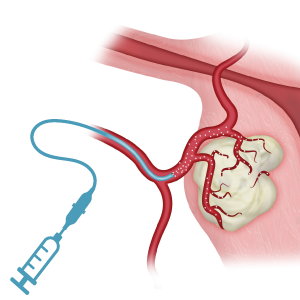Uterine Fibroid Embolization
Uterine Fibroid Embolization: A Safe and Effective Treatment for Uterine Fibroids
Watch the Recording of our Free Virtual Event
Fibroids are benign (non-cancerous) tumors that grow on or within the lining of the uterus.
They can cause intense pelvic pain or discomfort, frequent urination, urinary incontinence and heavy menstrual bleeding. In some cases, the symptoms of fibroids may be controlled with medication. When treatment is needed, a safe procedure called Uterine Fibroid Embolization (UFE) is available at Precision Therapy of Imaging Healthcare Specialists (IHS) of Southern California.
During the UFE procedure (also known as Uterine Artery Embolization or UAE), your Imaging Healthcare Specialists’ Interventional Radiologist uses imaging guidance to thread a small catheter through the body to the site of the blood vessel feeding the fibroids. When the catheter reaches the location of the fibroids, the radiologist embolizes or blocks the blood vessels that feed the fibroid, depriving it of oxygenated blood.
UFE is performed on an outpatient basis at our centrally located San Diego treatment center. The procedure generally takes an hour and the patient returns home the same day.
Here are some of the most commonly-asked questions regarding Uterine Fibroid Embolization (UFE).
UFE is a minimally invasive procedure that involves blocking the blood supply to fibroids in the uterus, causing them to shrink and eventually die.
During UFE, a radiologist inserts a small catheter through a tiny incision in the wrist or groin and guides it to the arteries that supply blood to the fibroid. Small particles are then injected through the catheter to block blood flow to the fibroids.
UFE is a safe and effective method for treating uterine fibroids. It is minimally invasive, has a shorter recovery time than surgery, and does not require general anesthesia.
As with any medical procedure, there are risks associated with UFE. These include bleeding, infection, and damage to other organs or tissues.
The procedure typically takes between one and two hours to complete.
Most women can return to normal activities within a week of the procedure. Full recovery can take up to two weeks.
UFE does not usually affect fertility, but it is important to discuss your individual circumstances with your doctor.
UFE has a success rate of around 90% in reducing symptoms of uterine fibroids, such as heavy bleeding and pelvic pain.
Fibroids may regrow after UFE, but the chances of this happening are low. Most women experience significant long-term relief from their symptoms.
UFE is typically covered by insurance, but it is important to check with your provider to confirm coverage and any associated costs.

